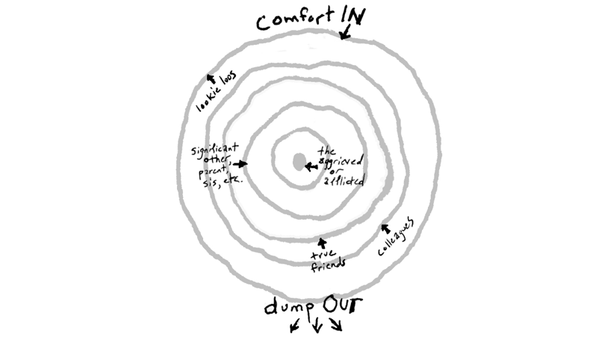April 16, 2018
In early 2015, during my father’s battle with cancer, I came across this 2013 gem of an article by Susan Silk and Barry Goldman in the LA Times on “how not to say the wrong thing” to someone undergoing a medical crisis. They called it the “‘Ring Theory’ on kvetching” and mentioned that it’s applicable to many different forms of crises.
The article is short and well-worth the read, but here’s the first of two excerpts I’m focusing on for this exercise in solidarity.
How Silk Ring Theory works:
Draw a circle. This is the center ring. In it, put the name of the person at the center of the current trauma. For Katie’s aneurysm, that’s Katie. Now draw a larger circle around the first one. In that ring put the name of the person next closest to the trauma. In the case of Katie’s aneurysm, that was Katie’s husband, Pat. Repeat the process as many times as you need to. In each larger ring put the next closest people. Parents and children before more distant relatives. Intimate friends in smaller rings, less intimate friends in larger ones. When you are done you have a Kvetching Order. […]
Here are the rules. The person in the center ring can say anything she wants to anyone, anywhere. She can kvetch and complain and whine and moan and curse the heavens and say, “Life is unfair” and “Why me?” That’s the one payoff for being in the center ring.
Everyone else can say those things too, but only to people in larger rings.
This article helped me process my grief over my father’s illness, and my anger at how I felt some people added onto my burden instead of alleviating it.
The framework also profoundly shaped the way I saw allyship and solidarity, issues I was exploring and pondering during my day job. In December 2014, for example, my colleague Margari Aziza Hill wrote about allyship from an Islamic perspective, exploring the “Islamic concept of wali” as “more than an advocate” and therefore “a trust from Allah“ that forms “the basis of our work in challenging racism […].”
The word “ally” has its issues, as you can learn more about in 2013 pieces by Mia McKenzie and Michyal Denzel Smith here and here. These problems have only worsened in some ways since the 2016 election results. However, since “ally” seems to be the most widely known term for this idea of someone who should be practicing solidarity, I’m going to use it as shorthand for this piece.
Ring Theory, illustrated by Wes Bausmith for the LA Times article at http://articles.latimes.com/20...ring-theory-20130407
One central concept in Ring Theory is that there’s an order of who is impacted most by the existing trauma. The person who is most impacted is centered. The people who are then next most impacted are placed in the rings that are one step out. And so on and so forth, until you have wider and wider rings that illustrate who is situated where in relation to the crisis.
Each person in the diagram has a place and each has a role to play. One diagram will look different from another depending on who is at the center, even for the same type of crisis (ex. Natasha and Ali, each fighting stage 3 lung cancer). New diagrams could be created for the same person depending on which crisis we’re thinking about (ex. Ayesha’s diagram for knee surgery vs. for getting fired from her job due to discrimination).
The Silk Ring Theory diagram is not an exact science, but it gives people a quick and easy shortcut to begin thinking more intentionally about who a specific crisis is affecting, and how someone should behave so as not to say the wrong thing.


Comments (0)